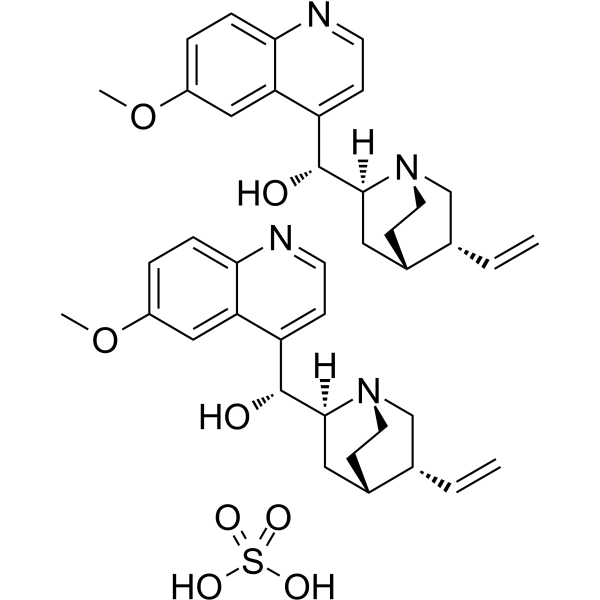804-63-7
| Name | quinine sulfate |
|---|---|
| Synonyms |
quinine hydrogen sulphate
(8α,9R)-6'-Methoxycinchonan-9-ol sulfate (1:1) Cinchonan-9-ol, 6'-methoxy-, (8α,9R)-, sulfate (1:1) (salt) EINECS 212-359-2 MFCD00078499 Quinine hydrogen sulfate Quinine sulphate chinidinesulfate Quinine sulfate |
| Description | Quinine sulfate (2:1) (Qualaquin) is an orally active alkaloid extracted from cinchona bark and can be used in anti-malarial studies. Quinine sulfate (2:1) is a potassium channel inhibitor that inhibits WT mouse Slo3 (KCa5.1) channel currents evoked by voltage pulses to +100 mV with an IC50 of 169 μM[1][2]. |
|---|---|
| Related Catalog | |
| In Vitro | Quinine sulfate (150 μM, 30 min) inhibits the proliferation and cytostatic effects of DENV (Dengue virus) in human hepatocarcinoma HepG2 cell line[1]. Quinine sulfate (37.5-150 μM, 24 hours) significantly reduces viral DENV RNA and protein levels in a dose-dependent manner in human hepatocarcinoma HepG2 cell line[1]. Cell Proliferation Assay[1] Cell Line: Human hepatocarcinoma cell line(HepG2) Concentration: 150 μM Incubation Time: 30 min Result: Inhibited DENV virus replication with 19% yield compared to untreated. Reduced DENV-positive cells from 23.28% to 12.05% in a dose-dependent manner. |
| In Vivo | Quinine sulfate (oral gavage, 12 or 15 mg/kg, every week, 16 weeks) has some tumor suppressing effect on skin cancer in Swiss albino mice[2]. Quinine sulfate (oral gavage, 10 mg/kg, everyday, 8 weeks) causes a decrease in the antioxidant defense system of rat testicular tissue such as SOD, CAT and GSH enzyme activity in male adult albino rats[3]. Animal Model: Swiss albino mice 7-8-weeks (weighing 24 g)[2] Dosage: 12 mg/kg, 15 mg/kg Administration: Oral gavage; every week; 16 weeks Result: Resulted in a significant reduction in tumor size and weight at 12 mg/kg and little effect at higher dose of 15 mg/kg. |
| References |
| Boiling Point | 911.6ºC at 760 mmHg |
|---|---|
| Molecular Formula | C20H26N2O6S |
| Molecular Weight | 422.495 |
| Flash Point | 505.1ºC |
| Exact Mass | 422.151154 |
| PSA | 128.57000 |
| LogP | 3.53910 |
CHEMICAL IDENTIFICATION
HEALTH HAZARD DATAACUTE TOXICITY DATA
MUTATION DATA
|
| RIDADR | UN 1544 |
|---|---|
| Packaging Group | III |
| Hazard Class | 6.1(b) |
